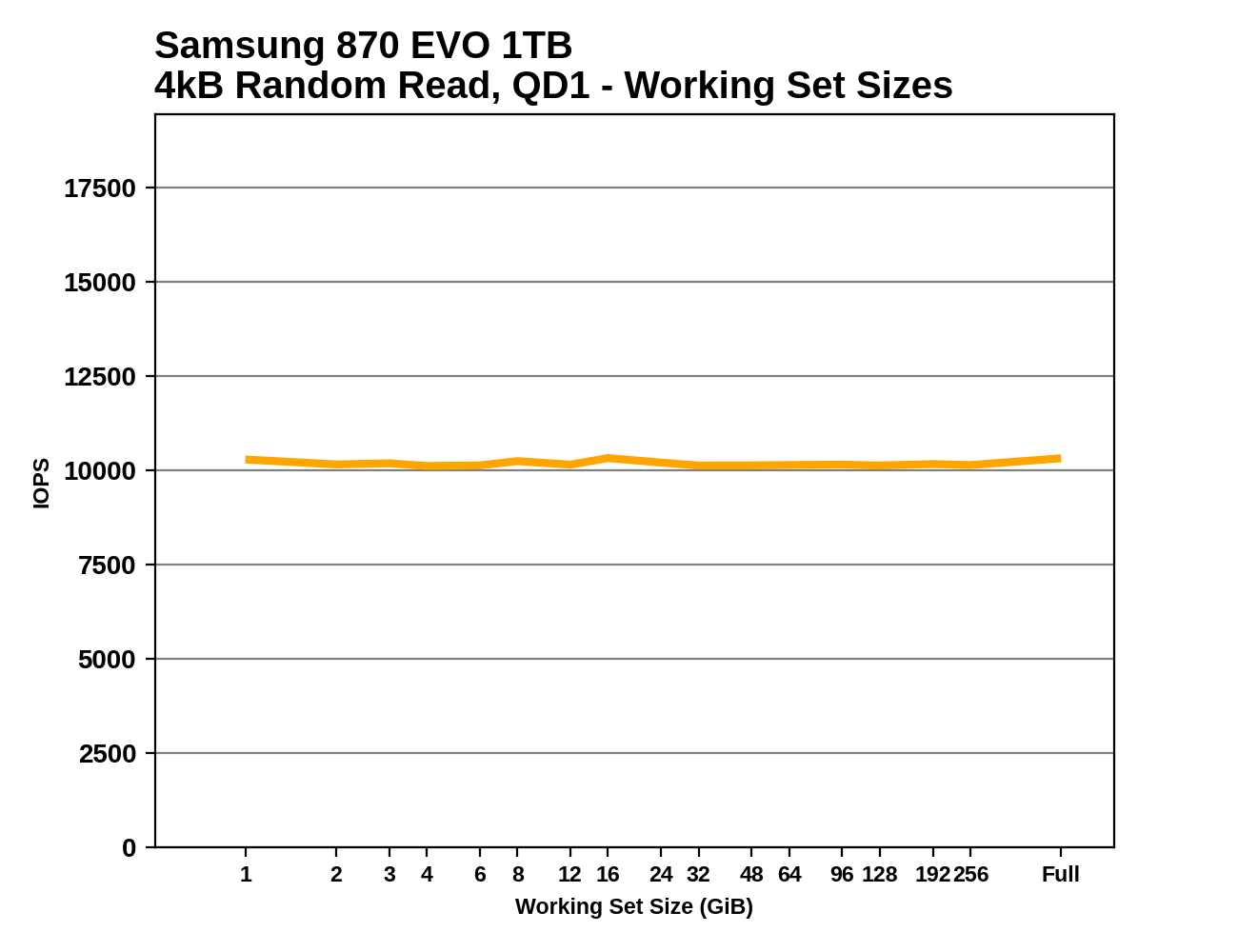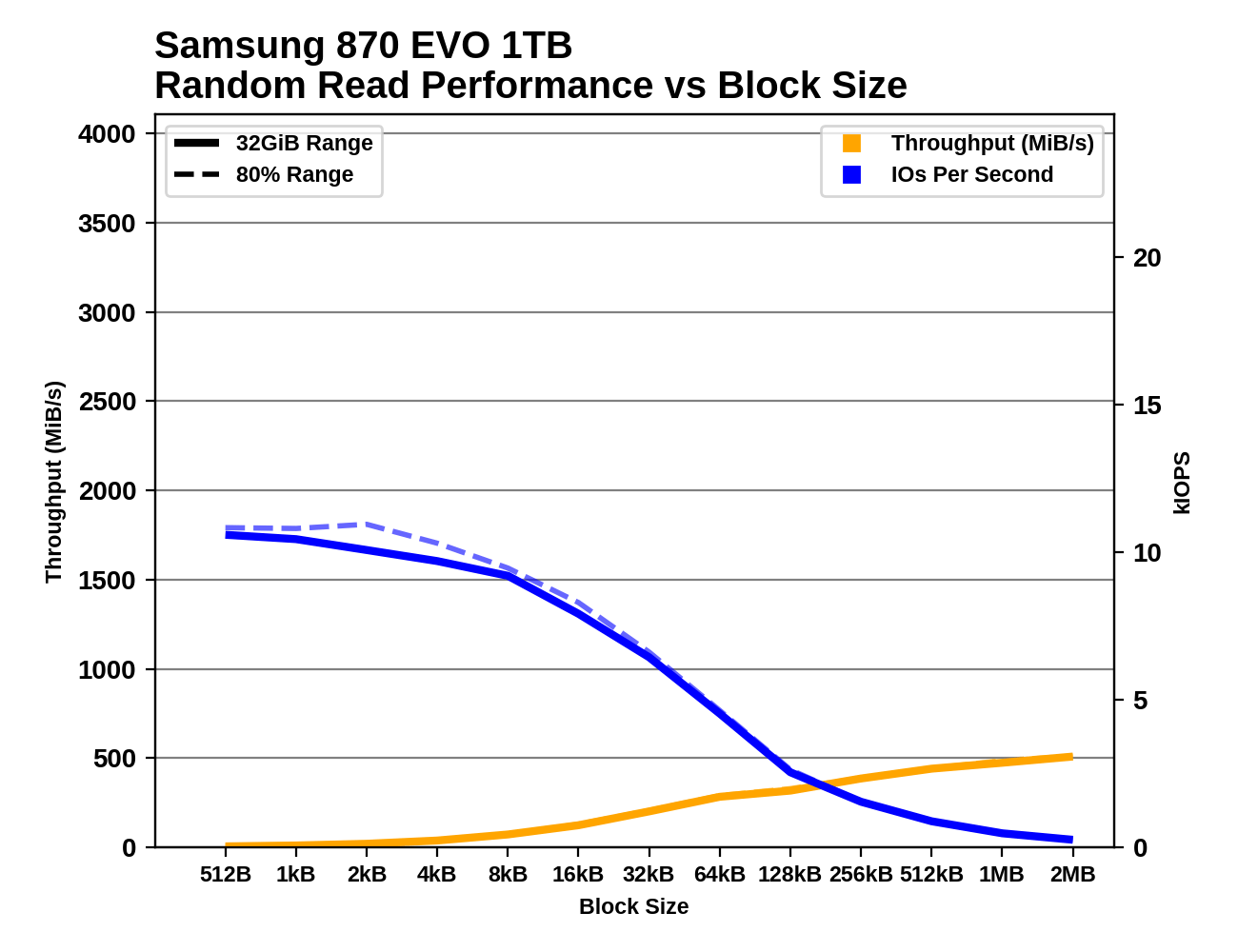The Samsung 870 EVO (1TB & 4TB) Review: Does the World Need Premium SATA SSDs?
by Billy Tallis on February 17, 2021 8:00 AM ESTAdvanced Synthetic Tests
Our benchmark suite includes a variety of tests that are less about replicating any real-world IO patterns, and more about exposing the inner workings of a drive with narrowly-focused tests. Many of these tests will show exaggerated differences between drives, and for the most part that should not be taken as a sign that one drive will be drastically faster for real-world usage. These tests are about satisfying curiosity, and are not good measures of overall drive performance. For more details, please see the overview of our 2021 Consumer SSD Benchmark Suite.
Whole-Drive Sequential Fill
 |
|||||||||
| Pass 1 | |||||||||
| Pass 2 | |||||||||
Some of our other tests have shown a few signs that the 870 EVO's write performance can drop when the SLC cache runs out, but this straightforward sequential write pass over the entire drive doesn't reveal any such behavior. The 870 EVO's sequential write performance is extremely consistent, even on the second write pass.
 |
|||||||||
| Average Throughput for last 16 GB | Overall Average Throughput | ||||||||
Due to the excellent performance consistency, the Samsung 870 EVOs edge out the other SATA drives with marginally higher average sequential write speeds. The entry-level NVMe drives end up much worse off than the mainstream SATA drives once their caches run out, but the more mainstream NVMe drive blows them all away.
Working Set Size
 |
|||||||||
As expected, the Samsung 870 EVO's random read performance shows basically no variation across a range of working set sizes, and that read performance is at least a little bit faster than any of the other SATA drives or the entry-level NVMe drives.
Performance vs Block Sizes
 |
|||||||||
| Random Read | |||||||||
| Random Write | |||||||||
| Sequential Read | |||||||||
| Sequential Write | |||||||||
There are no particular surprises in how the Samsung 870 EVO handles IOs of different block sizes. Unlike some drives, it has no trouble with sub-4kB IOs. It offers moderate improvements over the 860 EVO for mid-sized random reads (up to about 128kB). The one negative is that for writes we again see more inconsistency from the 870 EVO than the 860 EVO when testing an 80% full drive. The simple whole-drive sequential write test may not have been able to reveal any SLC caching troubles, but it does seem clear that the caching behavior has some performance regressions for more complicated workloads on a drive that's more well-used—though it's still unlikely to matter for any typical real-world consumer workload.










136 Comments
View All Comments
Oxford Guy - Friday, February 19, 2021 - link
2TB for $200 I meant.Shlong - Thursday, February 18, 2021 - link
SATA is necessary if you need multiple drives. I only have two M.2 slots on my motherboard but numerous SATA ports. I have a 512GB boot drive and 1TB data drive in both slots. I need more storage so I have a couple 2TB SATA SSD's connected.ET - Saturday, February 20, 2021 - link
You're confusing SATA with the disk form factor. There are SATA M.2 drive, SATA 2.5" drives and SATA 3.5" drives. SATA M.2 drives get their power from the same connector, by the way.The box size has little to do with the interface, more to do with case compatibility. Cases which are built to house multiple drives have spaces set up for them. That's a standard and both cases and drives are designed for it. The drive could theoretically be designed to be smaller (and there were 1.8" drives in the past).
TelstarTOS - Wednesday, February 17, 2021 - link
More common? Yes.Cheaper? Hell no. Still over 10c/GB
Kurosaki - Wednesday, February 17, 2021 - link
A shame the 3 TB version is 379 USD to expensive. This will never work unless price per GB falls to a quarter of today's, and reliability data retention wise gets at least on par with the spinners. 479 for 4TB is just ridiculous.ksec - Wednesday, February 17, 2021 - link
SATA SSD are not intended for Speed though. They are aiming at large storage HDD replacement. Give me a QLC SATA 8TB for $399 and I will still buy it.Oxford Guy - Friday, February 19, 2021 - link
With 8TB it might not be quite so horrible.flyingpants265 - Thursday, February 18, 2021 - link
SSDs can do 3000mb/s or a lot more with parallelization and raid, you could probably get 30,000mb/s or some insane number like that, eventually with a single SSD.It's a little weird that we don't have better cables.
Great_Scott - Thursday, February 18, 2021 - link
It's interesting to see the SATA market deteriorate.I don't understand how most PCs can get away with two or one physical drive slots, but assuming that remains the trend, I wonder what NAS owners are going to do once SSDs are cheap and large enough to use for RAID but there aren't any products to use for it...
mooninite - Wednesday, February 17, 2021 - link
Why should rotating rust drives still be shipped with 512e sectors?It must be the same marketing data these manufacturers are using to show they still need to make SATA SSDs.